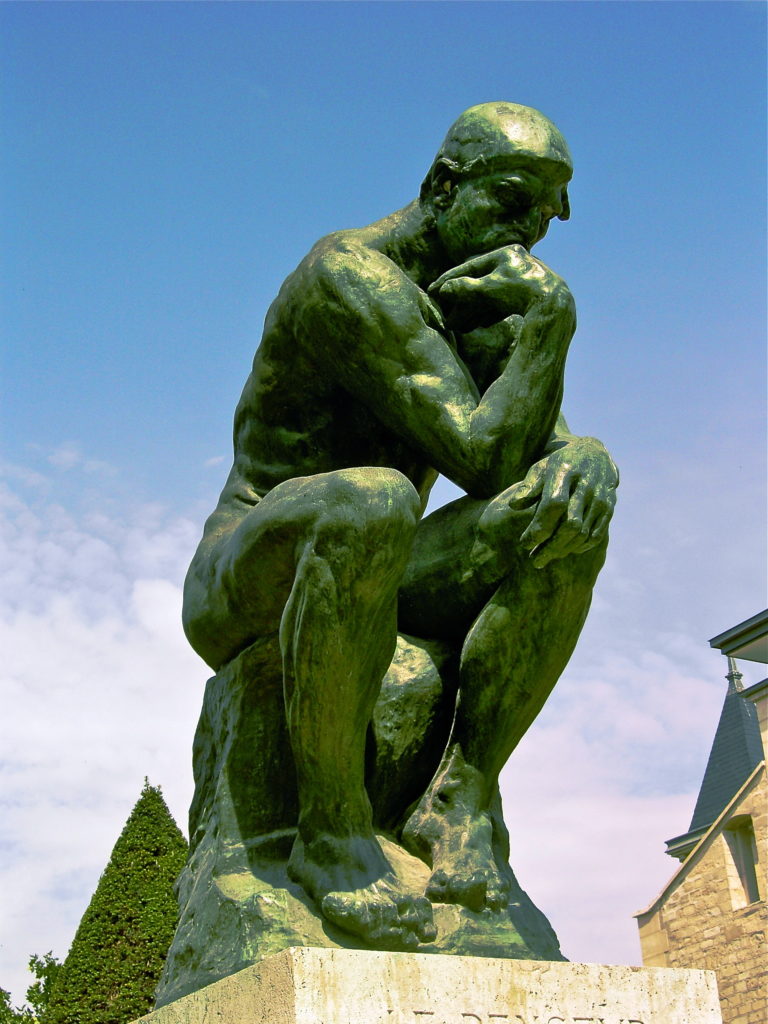Each year The New Media Consortium reports on key trends, significant challenges, and important developments in the field of educational technology. Among the significant challenges of 2015 was teaching complex thinking (Johnson, Becker, Estrada, & Freeman, 2015). The problem itself is complex enough that we could refer to it as a “wicked problem.” According to Koehler and Mishra, these are described as problems that “have incomplete, changing and contradictory requirements” (as cited in Week 4 – Learn, 2017).

“Rodin’s The Thinker” by Andrew Horne, retrieved from https://commons.wikimedia.org/w/index.php?curid=15582363, is licensed under Public Domain.
Because of the changing nature of wicked problems, it is impossible to come up with a perfect solution. Instead, my team Laura Allen, Guadalupe Bryan, Alex Gorton, and I worked to investigate and try to offer a “best bad idea” in response to the problem of teaching complex thinking (as cited in Week 4 – Learn, 2017).
We approached this wicked problem from the perspective of A More Beautiful Question. We hoped to ask “an ambitious yet actionable question that can begin to shift the way we perceive or think about something – and that might serve as a catalyst for change” (Berger, 2016, p. 8). Although our problem is unsolvable, we can still be a catalyst for change – if we know what to do.
Using the method presented in A More Beautiful Question, we asked Why, What If, and How. The most challenging aspect of this approach was giving time and thoughtful consideration to each phase in order to ask good questions. Berger points out that we’re deluged with answers, but “to get to our answers, we must formulate and work through the questions ourselves” (Berger, 2016, p. 3).
In our shared planning document, we brainstormed and took notes. Together, we asked 55 Why questions. When we ask Why, it helps to approach the problem from an inquisitive, almost childlike perspective. This led to our beautiful, driving question:
How are teachers addressing the complex thinking skills necessary for students to become productive and innovative 21st-century learners?
I needed to give our complex problem the consideration it deserved. Before moving on to the What If phase, I crafted this infographic about the complexity of our problem:
After arriving at our driving question, we responded by asking What If. When we ask What If, we use creative, divergent thinking to expand the possibilities to explore.
Around this time, we surveyed other educators in our professional learning networks (PLNs) about our wicked problem. Based on the results of the survey and on the What If questions we asked, our team singled out one What If question:
What if students had more freedom/choice in developing their complex thinking skills?
With our survey results in and our What If question settled on, we investigated current research around the question of How. We researched four current educational trends around student choice: project-based learning, genius hour, authentic inquiry, and student choice in assessments.
Check out our ThingLink below to see our group’s presentation of this entire process. We describe our methods, survey and results, and practical ways to introduce student choice in a 21st-century classroom. Don’t miss our references in the lower left if you want to learn even more. (If your browser doesn’t allow you to click on all the links, go directly to the ThingLink site.)
Reflections
Collaborative teamwork is a 21st-century skill that our group used to great effect. Even though we were never all in the same room for this, apps like Zoom, text messaging, Google Docs, and email helped us undertake this complex project.
The process was challenging at times, but the results were worth it. I am excited to try out some of our suggestions in my own class this fall.
References
Berger, W. (2016). A more beautiful question: The power of inquiry to spark breakthrough ideas. New York: Bloomsbury.
Johnson, L., Becker, S. A., Estrada, V., & Freeman, A. (2015). NMC horizon report: 2015 K-12 edition. Austin, TX: The New Media Consortium.
Week 4 – Learn. (2017, July 22). Retrieved from http://www.msuedtechsandbox.com/MAETely1-2017/week-4-wicked-problems/week-4-learn/
Images
Unless otherwise captioned, all images and videos in this blog post were created by Sarah Van Loo or the students of MAET Year 1.
